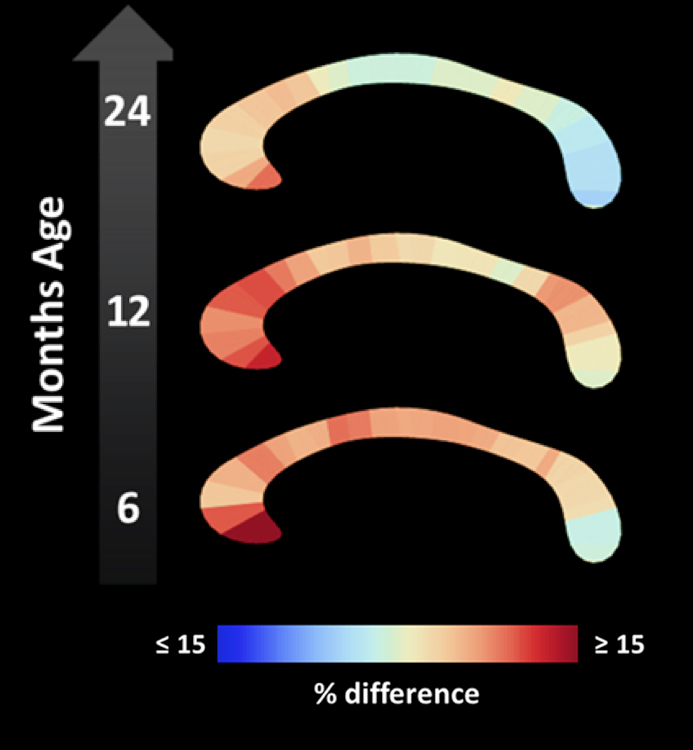
THIS ARTICLE IS MORE THAN FIVE YEARS OLD
This article is more than five years old. Autism research — and science in general — is constantly evolving, so older articles may contain information or theories that have been reevaluated since their original publication date.
The bundle of nerves that bridges the brain’s two hemispheres is abnormally thick in infants who are later diagnosed with autism, according to a study published 3 May in Brain1. The broader the bundle, the more severe a child’s repetitive behaviors at age 2.
The study adds to mounting evidence implicating the corpus callosum in autism. About one in three people born without a corpus callosum meet the criteria for autism.
Studies have generally found that the corpus callosum is unusually small in school-aged children and adults with autism. The new study is the first to look at changes in the corpus callosum in infants and toddlers before autism diagnosis, and finds the opposite pattern.
“I think it really drives home to us how important it is to think about how much the brain changes throughout life,” says lead investigator Jason Wolff, assistant professor of educational psychology at the University of Minnesota in Minneapolis.
The results are partially consistent with a 2014 study that reported the corpus callosum is abnormally large in children with autism, but then shrinks with age. In the new study, the corpus callosum appears to revert to normal by age 2. Wolff believes, however, that if he were to follow the infants longer, he would see that the structure becomes unusually thin with age in those who have autism.
There is no overlap in age between the two studies. “So it’s like trying to fit two totally separate pieces of a puzzle together,” says Brittany Travers, assistant professor of kinesiology at the University of Wisconsin-Madison. “But it looks like they could fit.” Travers was a member of the 2014 research team, but was not involved in the new study.
Size matters:
Wolff and his colleagues used magnetic resonance imaging (MRI) to scan the brains of 378 infants, 270 of whom have an older sibling with autism. These so-called ‘baby sibs’ are at 20 times the average risk of autism.
The researchers measured the corpus callosum at 6, 12 and 24 months of age. They then assessed the children at age 2 for repetitive behaviors, social deficits, communication difficulties and other autism symptoms. At that age, 57 of the baby sibs merited an autism diagnosis.
After controlling for differences in total brain volume, the researchers found that the corpus callosum in 6-month-old baby sibs with autism is about 15 percent thicker than it is in babies without autism, regardless of family history. The structure is broadest in the portion located near the front of the brain that integrates movement and sensory information.
This difference in thickness persists at 12 months, but fades almost entirely by 24 months. It’s unclear whether this relative thinning stems from faster thickening of the bundle in unaffected babies, slower growth in children with autism or both.
The findings are in accord with those of a study published in April that suggest that, relative to controls, the corpus callosum in children with autism loses structural integrity over time.
Although the new study suggests that infants with autism as a group have an enlarged corpus callosum, it is possible that this is true in only certain genetic subtypes of the disorder, says Elliott Sherr, professor of neurology and pediatrics at the University of California, San Francisco, who was not involved in the study. He says his team has unpublished evidence that the corpus callosum is abnormally large in people who lack a copy of the autism-linked chromosomal region 16p11.2 and abnormally small in people who carry an extra copy of the same region.
Wolff says he does not see an obvious subgroup among the children with autism that could be driving the overall group differences he found. Still, his team is collecting DNA samples from all of the babies in the study and their immediate family members. They plan to comb the samples for genetic clues to the causes of altered corpus callosum development.
It’s as yet unclear whether the corpus callosum alterations are a cause or a consequence of autism. “All we can say is that this is present probably before a diagnosis is possible,” Wolff says.
Wolff and his colleagues also discovered that the children who had the thickest corpus callosum as infants tend to have the most severe repetitive behaviors as toddlers. They did not see a relationship between size of the nerve bundle and other autism-like symptoms.
Researchers should look at whether discrepancies in corpus callosum size track with particular types of repetitive behaviors, says Thomas Frazier, director of the Center for Autism at the Cleveland Clinic in Ohio, who was not involved in the new work. “Breaking these things out is important for us to fully understand what brain regions and what brain developmental abnormalities are driving certain aspects of autism.”
Reference:
1. Wolff J.J. et al. Brain Epub ahead of print (2015) PubMed
By joining the discussion, you agree to our privacy policy.